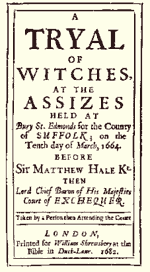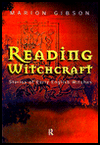Reading witchcraft texts

Report of a case in 1662,
not 1664 as stated here
and by many historians

When reading any historical document, one always needs to consider who the author was and what interests the author brings to the composition of the text, what the historical circumstances of writing it were, and who was the intended audience. These are essentially the aims of any hermeneutic enquiry, examining the rhetoric of a piece of writing. In the case of witchcraft pamphlets, there are some especial problems which make it difficult to use them as straightforward evidence. Several well-known and seemingly veracious pamphlets appear to be entirely fictitious, composed solely to make money. Others are written at such a distance from the events that it is hard to give them much credence as factual accounts. Nevertheless, all pamphlets are evidence of something, if only the writers' view of what would sell well.
Questions to ask, when deciding how to use a witchcraft pamphlet:
1.) Who was the author? In the case of anonymous
pamphlets, some indications may be gleaned by looking at the tone of the
preface or the main text, and by considering how much access the author
had to legal documents and extraneous material about those involved.
2.) Is there more than one author, perhaps because a
manuscript account has been edited for publication? Consider changes
in tone and access that occur during the pamphlet.
3.) Was the author (or authors) present at the trial,
as shown by descriptions of trial events?
4.) What is the origin of the information? Can
we rely on the names, dates, evidence, anecdotes?
5.) Were the author's sources written or oral?
6.) Did the author have access to pre-trial documents,
such as depositions and indictments? How?
7.) Does the author show a good understanding of the
legal process, or are there obvious errors?
8.) Does the author (or authors) report accurately what
his understanding of the material is? If not, why not?
9.) What is the author's viewpoint? Is this a political
intervention in a debate? Why was the pamphlet published when it
was?
 [The
remarks above are partly based on Marion Gibson, Reading Witchcraft:
Stories of Early English Witches (London, 1999), which should be consulted
for a fuller treatment of these issues.]
[The
remarks above are partly based on Marion Gibson, Reading Witchcraft:
Stories of Early English Witches (London, 1999), which should be consulted
for a fuller treatment of these issues.]
MODERN EDITIONS
A further set of problems arises with translations and
extracts from texts provided by historians, in collections or appendices:
1.) Is the text provided in full? If the text has
been edited, what has been omitted?
2.) Were there visual elements, such as woodcuts or varying
typography, which perhaps formed an important part of how the original
readers would have understood the text but which have not been reproduced?
3.) Why has the editor excluded parts of the text?
Is there an agenda at work or was this a pragmatic issue, such as cost
or space?
4.) What difference do the exclusions make to how one
understands the text?
5.) If a manuscript text has been transcribed, how reliable
is the transcriber?
6.) If a text has been translated, how reliable is the
translator?
Historians and others who work on witchcraft cases often have very strongly held positions, which they back up by citing primary sources, often at length. This can, in itself, lead to problems of interpretation, but this should not be too critical, provided the sources are used responsibly. Unfortunately, this is not always the case. Indeed, sometimes authors on witchcraft misrepresent their sources, whether primary or secondary, quite egregiously. One needs to ask of the secondary sources whether or not the authors have read the texts in the original, if it is available. Has an author been misled by the omissions from the edited text, or by errors in the translation? Are there variants or manuscript versions that have not been consulted, which might make a difference to how the text should be interpreted? Are there other documents which should have been compared with the printed source to establish its reliability? Is the author wilfully misreading the text or quoting passages out of context?
All too often, undergraduate students have little experience using articles and monographs written by scholars working in the field. Material is presented to them in predigested form, by means of textbooks and course readers. This being a class almost entirely populated with seniors, you will be expected to develop a critical understanding of the writings of historians, seeing the ways in which they create the subject of study and debate its character among themselves. It is necessary to examine the ways in which arguments are constructed and primary sources are used to substantiate arguments. Among historians, theoretical presuppositions are often left unstated. It is necessary to bring them out into the light of day in order to see how they shape the historian's construction of the subject.
For efficient reading of secondary material, one needs to learn the technique of "gutting" a book. Articles too can be read efficiently or inefficiently. The first thing to decide is whether you need to read the whole text, or are merely looking for some particular material to use in an essay. If the latter, then you need to make full use of the book's index and the table of contents. Locate the item you need and read around it only enough to make sure you are not wrenching it out of context. Check the notes to see where the author got it from, in case you can use a source nearer to the origin of your piece of information.
If you need to read the whole book or article, because you need to understand the author's position, start by working out what the author is arguing before you plunge into the text. In the case of a book, read the introduction, the table of contents, and the conclusion, if there is one. This should tell you what the author's intention is and how the argument will proceed. In each chapter, read the opening pages and the closing pages first. This should tell you what is chapter is doing, as a unit in the overall argument. Authors usually tell their readers what they are trying to do and whether they believe they have succeeded. In the case of articles, this should be even clearer, as the first page or two and the last page or two should make it crystal clear what is going on in the body of the article. (If you have to wait until the sixth page before you see the purpose, you have probably got it wrong!) You can then read the book or article in full knowledge of the aim, seeing how each chapter, or section, or item of evidence fits into the overall scheme. You will then be reading actively rather than passively, so the task will be easier and more enjoyable.
You will then be able to adopt a critical attitude towards
the book or article, instead of treating it as written on tablets of stone.
A few questions to ask, in reading secondary sources:
1.) How old is the item in question? What was the
state of the historiographical debate at the time?
2.) Does the author engage openly with current research?
What position is adopted?
3.) What kinds of primary sources have been consulted?
Are there other sources, either for the region concerned or available to
historians of other regions, that might have shed a different light?
4.) Does the author utilize comparisons with other regions
or periods? If so, how competently?
5.) What are the theoretical positions, or unspoken assumptions,
espoused by the author?
6.) Does the author's position illuminate or obscure
the material examined?
7.) Are there any items cited in notes that might help
you to reach a different conclusion?
An especially useful kind of clue to watch out for, when assessing an author's trustworthiness, is the long-discredited myth, still being trotted out in order to make a point. The "400 in one day" trial, often cited by polemical authors and found everywhere on the Internet, never happened. It comes from Etienne Leon de Lamothe Langon's forged witch trials, which were exposed by Cohn and Kieckhefer nearly thirty years ago. For over a decade, virtually no serious historian of either witchcraft or midwifery has believed that midwives were frequently prosecuted as witches, yet one still finds this notion being rehearsed in print, with spurious or exceptional examples produced in evidence.
Finally, in using the secondary material reprinted in
the class reader, one ought to consider why the editor has chosen each
particular piece and decided to include the particular passages printed.
The editor has an agenda, just as the original authors did. Although
the omission of footnotes may well have been forced on the editor by the
publishers, one ought also to consider what is the effect of reading an
argument without the references.
Index